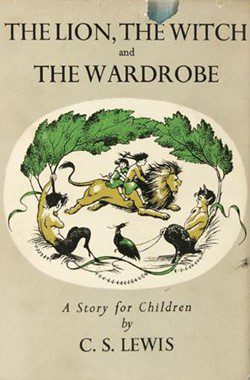The views expressed in our content reflect individual perspectives and do not represent the authoritative views of the Baha'i Faith.
Should it be God’s intention, there would appear out of the forests of celestial might the lion of indomitable strength whose roaring is like unto the peals of thunder reverberating in the mountains. – Baha’u’llah, Tablets of Baha’u’llah, p. 197.
Have you ever felt God calling you, with just an insistent small tug of your soul deep inside? I did.
When I first read C.S. Lewis’ children’s fantasy phenomenon The Chronicles of Narnia as a 12-year-old, I got the allegory even then.
Narnia stood for the spiritual world, the Emperor-Beyond-the-Sea symbolized God, the White Witch embodied evil or Satan (himself symbolic), the wardrobe represented faith, by which we entered the spiritual realm, the Lion, Aslan, of course, embodied Jesus Christ, the Stone Table was the cross, Lucy and Susan were Mary and Martha, Edmund was Judas (or any of us), “Peter” the high king was the church–all obvious enough for any child who had stayed awake in Sunday school.
 After finishing the seven-book series, I so longed for that Narnian world to continue that, in a move that prefigured a lifetime of audacious and quixotic projects, I took it upon myself to write the eighth Chronicle. I named my slim volume The Three Fires, in which I, to make the homage to the Chronicles complete, constructed my own allegory of the Trinity, however crude. My enrollment in an eighth grade typing class came not a moment too soon, as I used the newfound skill to peck out its fifty-seven pages on my grandmother’s Smith-Corona. With the help of my father, I got seven copies run off and spiral bound and hand colored each of the seven covers before having them laminated.
After finishing the seven-book series, I so longed for that Narnian world to continue that, in a move that prefigured a lifetime of audacious and quixotic projects, I took it upon myself to write the eighth Chronicle. I named my slim volume The Three Fires, in which I, to make the homage to the Chronicles complete, constructed my own allegory of the Trinity, however crude. My enrollment in an eighth grade typing class came not a moment too soon, as I used the newfound skill to peck out its fifty-seven pages on my grandmother’s Smith-Corona. With the help of my father, I got seven copies run off and spiral bound and hand colored each of the seven covers before having them laminated.
In ninth grade, I sampled The Screwtape Letters, Lewis’ playful apologetic written by a conniving Satan. Then I moved on to rock-n-roll, girls, cars, video production and other activities more befitting a teenage American boy.
But Lewis hadn’t finished with me. Our second encounter came when I reached the age of 27, and delved for the first time into Lewis’ nonfiction, Mere Christianity, an anthology of transcribed radio talks in which he argues for Christianity in a style marked by simplicity, easily-grasped metaphors, and air-tight logic. I was so influenced and taken with the book that a slew of his other apologetics followed: God in the Dock, The Problem of Pain, Miracles.
Clive Staples Lewis, born in Ireland in 1898, was a staunch atheist from the age of 15 to 31. He eventually became a professor of medieval literature at Oxford, and, influenced by arguments with his Oxford colleague and close friend J.R.R. Tolkien, and by the book The Everlasting Man by G. K. Chesterton, he slowly rediscovered faith. Lewis said he was brought into Christianity like a prodigal, “kicking, struggling, resentful, and darting his eyes in every direction for a chance to escape.”
Following his acceptance of God in 1929, Lewis converted to Christianity in 1931. After a long discussion and late-night walk with his close friends Tolkien and Hugo Dyson, he records making a specific commitment to Christianity while on his way to the zoo with his brother. He became a member of the Church of England, somewhat to the disappointment of Tolkien, who had hoped he would convert to Roman Catholicism.
The close friendship between Lewis and Tolkien was on some level reenacted by my neighbor across the street and me, when he became the world’s foremost 10-year-old authority on Tolkien’s Middle-earth and I acquired similar credentials for Narnia. We were a Muppet Babies version of the Oxford dons themselves. Having cleanly divided children’s fantasy literature thusly freed us each to specialize in our areas all the more completely. Only occasionally during our long summer days playing together did orcs encounter centaurs.
Lewis wrote The Chronicles of Narnia between 1949 and 1954, and died nine years later, leaving a robust catalogue to convert and inspire Christians for at least a century to come, and most pointedly a body of apologetics in favor of basic belief in the divine. For their part, The Chronicles of Narnia have sold more than 100 million copies and various books within the series have been adapted for film, TV, radio, and stage. His legacy was never given its full due at the time of his death, as he died on November 22, 1963, the very day President Kennedy was assassinated. What little space was left that day for obituaries he had to share, incredibly, with Aldous Huxley.
Cloaked in the form of a clever fairy tale, The Chronicles of Narnia uses allegory to illuminate an impressive array of spiritual truths and dynamics.
I had not re-read The Lion, the Witch, and the Wardrobe for 30 years, until recently, when I read it aloud to my two sons. In the meantime, I had gone on a long spiritual and intellectual journey, which had culminated in my embrace of the Baha’i Faith, a religion which claims that its founder, Baha’u’llah, fulfills the prophecy of the second coming of Jesus Christ, as well as the messianic promises of all historic religions.
So come along with my sons and me as we explored these beautiful metaphorical works of art, and let’s see if C. S. Lewis and J. R. R. Tolkien can inspire you the way they have so many others.
















Comments
Sign in or create an account
Continue with Googleor